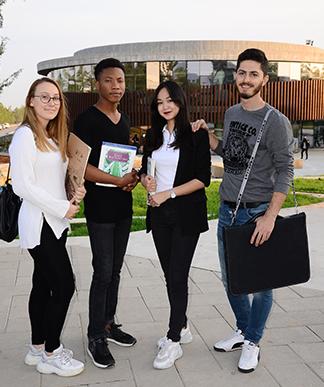


About the Program
Graphic Design Master’s Program (M.FA.) takes the main field of design as its foundation; it is also structured as a flexible program to be help its graduates be ready to work in creative industries and be open to interdisciplinary approaches. Some of these creative industries are art, illustration, cinema, new media, animations and photography which could be accepted under the umbrella of visual culture. The aims of CIU Graphic Design M.FA. Program are to analyze the visual media through graphic design which is gaining more importance day-by-day in global communication and cultural context; and encourage student’s personal approaches and solutions. The objectives of the program cover understanding the design thinking, detecting the problems of the time, ability to work with an interdisciplinary approach, acknowledging the importance of the mission of design profession as creating a better world, understanding of the zeitgeist, and ability to improve critical comprehension. Our mission is to guide design professionals and prospective academics who have gained visual culture and aesthetic perspective, are social, student- and learning-oriented, and have gained interdisciplinary and multidisciplinary working skills.
Our vision is to be open to change and development; embrace the soul of the time; to build a positive and participative communication between the university and society; know the creative industries and lead multidisciplinary projects; as well as contributing to national and international art and culture environment. The students work on interdisciplinary projects in media, design, and communication for creative industries. The program aims to contribute to the recognition of our university and country by participating in national and international art and design events with creative artistic projects. It is also aimed to raise well-prepared students for a Ph.D. degree in art.
Education Opportunities
The students of the CIU Graphic Design Master's Program work on a research project and participate in exhibitions. Current design problems are discussed in the courses and solutions are suggested. Students are encouraged to participate in academic research, academic symposia and seminars, and to publish in academic journals.

Career Areas
The graduates of the Graphic Design Master’s Program (M.FA.) can work in all creative industries or decide to continue for a Ph.D. in art to further their academic education. Students who wish to improve their academic progress can work on design theory and practice. The program is linked to the Department of Graphic Design, which has been a member of the International Design Council (ico –D) since 2015. The program updates its curriculum according to the education manifest of ico-D.
Contact
Institute of Graduate Studies and Research
Graduate Sciences and Education Center, GE106
Tel: +90 392 671 1111 Extension: 2776
Institute E-mail: ciu-institute@ciu.edu.tr
Compulsory Courses
First Semester
GRAPHIC DESIGN I
Course code
GRDE501Credit
3Theoretical
3Practical
0Ects
8ELECTIVE
Course code
GRDE5X1Credit
3Theoretical
3Practical
0Ects
8ELECTIVE
Course code
GRDE5X2Credit
3Theoretical
3Practical
0Ects
8ELECTIVE
Course code
GRDE5X3Credit
3Theoretical
3Practical
0Ects
8Second Semester
GRAPHIC DESIGN II
Course code
GRDE502Credit
3Theoretical
3Practical
0Ects
8SEMINAR
Course code
GRDE590Credit
0Theoretical
0Practical
0Ects
4ELECTIVE
Course code
GRDE5X4Credit
3Theoretical
3Practical
0Ects
8ELECTIVE
Course code
GRDE5X5Credit
3Theoretical
3Practical
0Ects
8Third Semester
THESIS
Course code
GRDE500Credit
0Theoretical
0Practical
0Ects
60Elective Courses
RESEARCH METHODS
Course code
GRDE509Credit
3Theoretical
3Practical
0Ects
COMPUTERS IN DESIGN
Course code
GRDE507Credit
3Theoretical
3Practical
0Ects
LIGHTING AND COLOR
Course code
GRDE504Credit
3Theoretical
3Practical
0Ects
0SEMIOTICS OF IMAGE
Course code
GRDE503Credit
3Theoretical
3Practical
0Ects
8ERGONOMICS
Course code
INAR505Credit
3Theoretical
3Practical
0Ects
10INTRODUCTION TO EXHIBITION DESIGN
Course code
INAR511Credit
3Theoretical
3Practical
0Ects
TYPOGRAPHY-I
Course code
GRDE205Credit
0Theoretical
0Practical
0Ects
FEMALE STEREOTYPES IN DESIGN
Course code
GRDE516Credit
3Theoretical
3Practical
0Ects
8CONTEMPORARYGRAPHIC DESIGN
Course code
GRDE312Credit
0Theoretical
3Practical
0Ects
COMPUTER AIDED GRAPHIC DESIGN-I
Course code
GRDE203Credit
0Theoretical
0Practical
0Ects
SCIENCE FICTION FILM AND LITERATURE
Course code
COMM531Credit
3Theoretical
3Practical
0Ects
10HISTORY OF DESIGN
Course code
GRDE311Credit
0Theoretical
0Practical
0Ects
HUMAN FACTORS IN ARCHITECTURAL DESIGN
Course code
ARCH526Credit
3Theoretical
3Practical
0Ects
DIGITAL PRACTICE
Course code
GRDE108Credit
0Theoretical
0Practical
0Ects
4FILM AESTHETICS
Course code
COMM513Credit
3Theoretical
3Practical
0Ects
10TYPOGRAPHY-II
Course code
GRDE206Credit
0Theoretical
0Practical
0Ects
COMPUTER AIDEDGRAPHIC DESIGN-II
Course code
GRDE204Credit
0Theoretical
3Practical
0Ects
MEDIA AND INTERNATIONAL CONFLICT
Course code
INRE561Credit
3Theoretical
3Practical
0Ects
NEW COMMUNICATION TECHNOLOGIES
Course code
COMM510Credit
3Theoretical
3Practical
0Ects
10GRAPHIC DESIGN-V
Course code
GRDE401Credit
0Theoretical
0Practical
0Ects
MESSAGE DESIGN AND MEDIA MANAGEMENT
Course code
COMM503Credit
3Theoretical
3Practical
0Ects
10TYPOGRAPHY I
Course code
GRAP205Credit
0Theoretical
0Practical
0Ects
ARCHITECTURE AND THE CITY IN SCIENCE FICTION MOVIES
Course code
ARCH619Credit
3Theoretical
3Practical
0Ects
0DESIGN ETHICS AND LEGAL ISSUES
Course code
GRAP407Credit
0Theoretical
0Practical
0Ects
GRAPHIC DESIGNETHICS AND LEGALISSUES
Course code
GRDE407Credit
0Theoretical
0Practical
0Ects
3ORGANIZATIONAL COMMUNICATION
Course code
COMM508Credit
3Theoretical
3Practical
0Ects
10LIGHTING DESIGN
Course code
INAR510Credit
3Theoretical
3Practical
0Ects
THEORY OF COLOUR
Course code
INAR513Credit
3Theoretical
3Practical
0Ects
COMMUNICATION SYSTEMS
Course code
COMM507Credit
3Theoretical
3Practical
0Ects
10COMPUTER VISION
Course code
ISYE537Credit
3Theoretical
3Practical
0Ects
ENVIRONMENTAL AESTHETICS
Course code
ARCH530Credit
3Theoretical
3Practical
0Ects
QUALITATIVE RESEARCH METHODS
Course code
COMM515Credit
3Theoretical
3Practical
0Ects
TİPOGRAFİ-II
Course code
GRAP206Credit
0Theoretical
0Practical
0Ects
VIDEOART AND MULTIMEDIA
Course code
GRAP306Credit
0Theoretical
0Practical
0Ects
GRAFİK TASARIM BİTİRME PROJESİ ARAŞTIRMASI
Course code
GRDE405Credit
0Theoretical
0Practical
0Ects
ADVANCED PHOTOGRAPHY
Course code
GRDE208Credit
0Theoretical
0Practical
0Ects
GRAPHIC DESIGN V
Course code
GRDE401Credit
0Theoretical
0Practical
0Ects
ADVERTISEMENT DESIGN
Course code
GRDE307Credit
0Theoretical
0Practical
0Ects
Students who are interested in pursuing advanced graduate studies leading to a master’s, doctoral degree, or professional doctorate degree for the Fall and Spring semesters every year. Applicants can directly apply online to our graduate programs using the application portal.
TRNC Applicants- Required documents:
- Bachelor’s Degree Diploma
- Bachelor’s Degree transcripts for each completed academic term/year.
- Documents to prove English proficiency for English language departments,
- Scanned copy of passport or identity card.
Click for detailed admission requirements information.
Students who are interested in pursuing advanced graduate studies leading to a master’s, doctoral degree, or professional doctorate degree for the Fall and Spring semesters every year. Applicants can directly apply online to our graduate programs using the application portal.
International Applicants- Required documents;
- Bachelor’s Degree Diploma
- Bachelor’s Degree transcripts for each completed academic term/year.
- Evidence of English Language competence: TOEFL (65 IBT) or IELTS (5.5). Students without these documents will take the CIU English proficiency exam on campus following arrival.
- Scanned copy of international passport/birth certificate
- CV
- Fully completed and signed CIU Rules and Regulations document (which can be downloaded during the online application)
Click for detailed admission requirements information.
Cyprus International University provides academic scholarships for its students as an incentive for success, with most students benefiting from 50%, 75% or 100% scholarships or discounted tuition fees. Click for more information.
Tuition Fees are determined at the beginning of each academic year. Candidate students who are entitled to enroll in CIU can learn their fees in line with the Tuition Fee Calculation system.